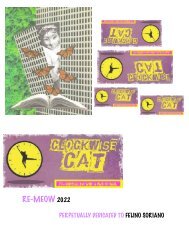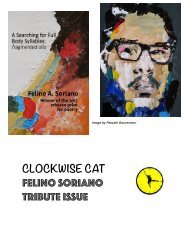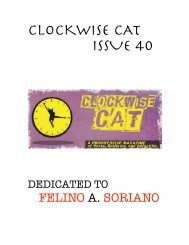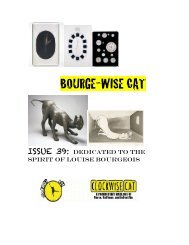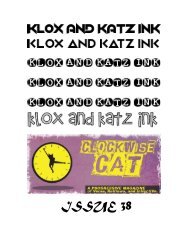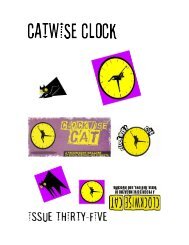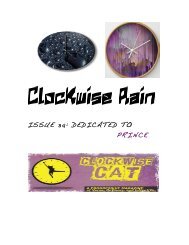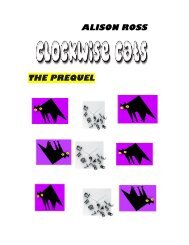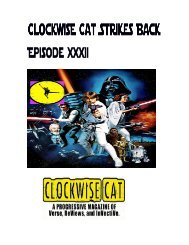THUGWISE CAT
Create successful ePaper yourself
Turn your PDF publications into a flip-book with our unique Google optimized e-Paper software.
Tenebrae, in Heller's poetic universe, is the opposite of darkness, despite its original<br />
meaning. Or, rather, it is a probing of the facets of darkness in order to irradiate:<br />
"...exploring underbellies, hidden contours, liberating the undisclosed..." (page 13).<br />
In Heller's conception of the world, what merits illumination most are the obscure, the<br />
arcane, the veiled, the shadow-dwelling...<br />
How this latest articulation of Hinge Theory works goes something like this: Words are<br />
"imported" from other contexts, where they have already established their own legitimacy,<br />
and they serve to embellish their new contexts. The words themselves are infused with<br />
novel dimensions (they "Bloom from their Immersions in Additional Communities"<br />
(page 15) ), and the new context benefits and thrives, as well. Exports, too, exist - those<br />
are the words that "vault" from one territory to another, and become the "Subject<br />
Scrutinized" (page 16). Mining is the final component of this multi-tiered theory, and<br />
yet...shouldn't it be the first? Mining is what occurs when one context/application is<br />
"consulted to enrich" the context "currently being investigated." (page 16).<br />
This whole theory is an exercise in slyly subverting linguistic stagnation: "The<br />
lexiconically Static is a Logos Abuser," Heller proclaims. Lexicons are intrinsically<br />
dynamic, and lexiconic vigor relies on savvy manipulation of diction and syntax, which<br />
in turn affects semantics. Hence, Hinge Theory.<br />
(Honestly, I find the whole theory adorably brilliant - somewhat Dickinsonian in its<br />
quaint but stern intellectuality, and somewhat Seussian in its whimsical erudition. It may<br />
be a reflection of my own poetic ethos that I locate a tenor of humor in it, but I do think<br />
deep down, Heller is also an astute scholar of the absurd.)<br />
The poems themselves can be overwhelming for a first-time reader, situated as they are at<br />
the far end of the experimental spectrum, with all the implications thereof of coldly cubist,<br />
robustly rational but soullessly mechanical. But, as I have already made clear, a patient<br />
reader will see beyond that deceptive surface, and come to bask in the wonderful<br />
wilderness of the Levinson Vernacular. These are not mere modern hieroglyphics. This is<br />
language re-imagined - deconstructed, re-constructed, re-deconstructed, and so forth.<br />
But now, alas, the poems. How does one even choose which poems to zoom in on? From<br />
one perspective, they are a big beautiful tangled mass, in need of careful unraveling. But<br />
that's for mathematical minds. My mind is fueled more by intuition and instinct, so I will<br />
focus on five poems that I believe are emblematic of my own (dubious?) discernment of<br />
Hinge Theory's logos-pathos dichotomy. I won't exactly explicate them, because that's a<br />
daunting exercise if there ever was one - and finally, an unnecessary one, a violation of<br />
their integrity.<br />
We start on page 20: "tenebraed to a Faded Aristocracy." The first part of the poem is a<br />
paragraph that stutters in succinct spurts : "louche carom. souse soliloquy. gongs. curtains.<br />
109




